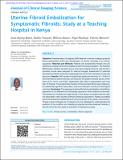Files in this item
Uterine Fibroid Embolization for symptomatic fibroids : study at a teaching hospital in Kenya
Item metadata
| dc.contributor.author | Mutai, John | |
| dc.contributor.author | Vinayak, Sudhir | |
| dc.contributor.author | Stones, William | |
| dc.contributor.author | Hacking, Nigel | |
| dc.contributor.author | Mariara, Charles | |
| dc.date.accessioned | 2015-07-14T11:10:01Z | |
| dc.date.available | 2015-07-14T11:10:01Z | |
| dc.date.issued | 2015-03-31 | |
| dc.identifier | 181077103 | |
| dc.identifier | df104728-671e-43fd-b94b-9ce0ea2d680a | |
| dc.identifier | 84940524927 | |
| dc.identifier.citation | Mutai , J , Vinayak , S , Stones , W , Hacking , N & Mariara , C 2015 , ' Uterine Fibroid Embolization for symptomatic fibroids : study at a teaching hospital in Kenya ' , Journal of Clinical Imaging Science , vol. 5 , 18 . https://doi.org/10.4103/2156-7514.154351 | en |
| dc.identifier.uri | https://hdl.handle.net/10023/6979 | |
| dc.description | This study was funded by the Aga Khan University Date of Acceptance: 24/02/2015 | en |
| dc.description.abstract | Objective: Characterization of magnetic (MRI) features in women undergoing uterine fibroid embolization (UFE) and identification of clinical correlates in an African population. Materials and Methods: Patients with symptomatic fibroids who are selected to undergo UFE at the hospital formed the study population. The baseline MRI features, baseline symptom score, short-term imaging outcome, and mid-term symptom scores were analyzed for interval changes. Assessment of potential associations between short-term imaging features and mid-term symptom scores was also done. Results: UFE resulted in statistically significant reduction (P < 0.001) of dominant fibroid, uterine volumes, and reduction of symptom severity scores, which were 43.7%, 40.1%, and 37.8%, respectively. Also, 59% of respondents had more than 10 fibroids. The predominant location of the dominant fibroid was intramural. No statistically significant association was found between clinical and radiological outcome. Conclusion: The response of uterine fibroids to embolization in the African population is not different from the findings reported in other studies from the west. The presence of multiple and large fibroids in this study is consistent with the case mix described in other studies of African-American populations. Patient counseling should emphasize the independence of volume reduction and symptom improvement. Though volume changes are of relevance for the radiologist in understanding the evolution of the condition and identifying potential technical treatment failures, it should not be the main basis of evaluation of treatment success. | |
| dc.format.extent | 9 | |
| dc.format.extent | 1163712 | |
| dc.language.iso | eng | |
| dc.relation.ispartof | Journal of Clinical Imaging Science | en |
| dc.rights | Copyright: © 2015 Mutai JK. This is an open‑access article distributed under the terms of the Creative Commons Attribution License, which permits unrestricted use, distribution, and reproduction in any medium, provided the original author and source are credited. | en |
| dc.subject | African women | en |
| dc.subject | Embolization | en |
| dc.subject | Fibroid | en |
| dc.subject | Response | en |
| dc.subject | R Medicine | en |
| dc.subject | NDAS | en |
| dc.subject.lcc | R | en |
| dc.title | Uterine Fibroid Embolization for symptomatic fibroids : study at a teaching hospital in Kenya | en |
| dc.type | Journal article | en |
| dc.contributor.institution | University of St Andrews.School of Medicine | en |
| dc.contributor.institution | University of St Andrews.Global Health Implementation Group | en |
| dc.identifier.doi | 10.4103/2156-7514.154351 | |
| dc.description.status | Peer reviewed | en |
| dc.identifier.url | http://www.clinicalimagingscience.org/text.asp?2015/5/1/18/154351 | en |
This item appears in the following Collection(s)
Items in the St Andrews Research Repository are protected by copyright, with all rights reserved, unless otherwise indicated.

